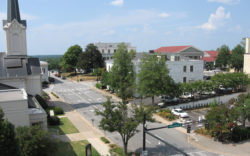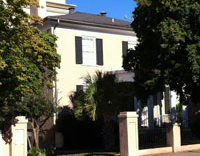Student housing is one of the most frequent bones of planning and development contention locally, and an issue that seems to come up again and again in bizarre ways. From a fraternity tearing down houses in a historically black neighborhood to build a plantation house to comical games of regulatory Whac-A-Mole with the builders of cheap, infill student houses in intown neighborhoods, local officials seem really at a loss to anticipate or manage these issues. Most recently, bulldozers have started rolling and are in the process of obliterating much of the Cedar Shoals, site of Daniel Easley and John Milledge’s historic meeting that led to the siting of the University of Georgia and the beginning of Athens. Oh, well… maybe we’ll catch the next one?
So, why is student housing such a force? It isn’t really economic development, even though it may create some construction jobs temporarily. Even when developers are compelled to add retail space to their projects, more often than not the spaces are simply used for leasing offices or remain vacant for years. In the case of buildings like 909 Broad and 755 Broad (formerly Georgia Traditions), the presence of hundreds of students upstairs or down the street hasn’t been the surefire bet for retail that one might hope.
Further, the construction of new bedrooms for students doesn’t result in new students. It simply shifts student population from one location to another. While enrollment at UGA has increased somewhat in recent years, it hasn’t kept pace with the vast glut of student-oriented housing that has concurrently emerged. Consider that the university currently has about 34,000 students in Athens. There’s housing for roughly 8,000 on campus, the majority of those being freshmen who are required to live on campus (except those living with their families nearby). Taking into account the 1,600 or so who live in fraternity or sorority houses, that leaves about 24,400 students out there in the housing market. Between projects recently completed, those under construction and those soon to start, there are well over 2,000 bedrooms entering the market, representing an increase in supply of around 10 percent. Of course, it’s not as if there are thousands of homeless students; either these developers have made huge miscalculations, or students will fill new developments, leaving older ones vacant.
So, what happens to the older ones? Venturing back a few decades into the archives of The Red & Black, I took a look at who was marketing apartments to students. Interestingly, certain student apartment complexes have had a great deal of longevity, especially those in the Riverbend Road area. Other areas, however, such as on the Eastside and along Atlanta Highway and Epps Bridge Road, no longer primarily serve the student population. Some have matured to become stable and diverse working-class housing, but some have become run-down or hotspots for crime over the decades. In a year or so, The Flats at Easley Mill will warehouse 300 students. Can we predict which 300 bedrooms will be vacant because of that? Do complexes and apartments designed to serve students have the adaptability necessary to be successfully repurposed into housing for Athens’ working class?
In trying to predict how the rental housing market will evolve over time, it’s also worth considering that the university’s decision effectively to provide subsidized transit to Riverbend and Milledge Avenue has played a major role in the longevity of those areas for student housing. All students pay a transportation fee, regardless of where they live, and while Athens Transit buses are available to students, their service to other parts of the city often isn’t nearly as frequent or direct as UGA’s.
On-campus housing routinely has a wait list that numbers in the high hundreds, and sometimes pushes past 1,000, according to several Red & Black pieces over the years. Should an antsy UGA Real Estate Foundation decide it’s time to meet that demand, it easily could. Dorm life also seems to build more demand for itself, with students coming back year after year in appreciation for the convenience, community, and academic experience that go with it. Indeed, many students are living off-campus only as a second choice, with those on the wait list perhaps representing only the most patient, or least mobile.
Another variable to consider is the university’s ability to compel students to live on-campus should it wish to, and its flexibility in terms of the types of housing it can provide. East Campus Village introduced apartment-style living alongside traditional shared dorm rooms. While there aren’t any huge projects in the pipeline, with a captive market, UGA could easily rock the local student housing industry. The dorm loft and futon industry, comprised of several small local companies, was decimated a few years ago when the university finally decided to include lofts in its high-rise freshman dormitories. While that was a good move in terms of eliminating the waste of so much lumber at the end of each semester, it demonstrates the dramatic scope of even a minor change in housing policy by the university.
UGA is this community’s biggest economic player, and its students are a major consumer force whose habits and decisions have drastic impact on the built environment. While we tend to decry students’ impacts on local neighborhoods, it seems that we don’t really have a good understanding of just how all the variables interact to produce those situations. Until we explore the issue more completely, we’ll likely continue to throw up our hands in frustration as new student housing pops up, often in the places we’d least desire it.
Like what you just read? Support Flagpole by making a donation today. Every dollar you give helps fund our ongoing mission to provide Athens with quality, independent journalism.










